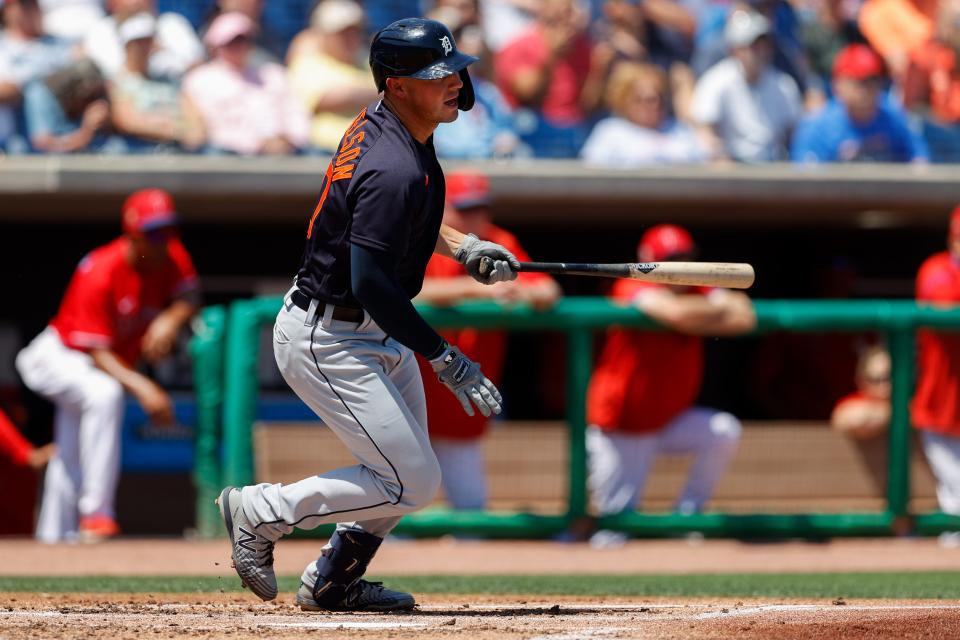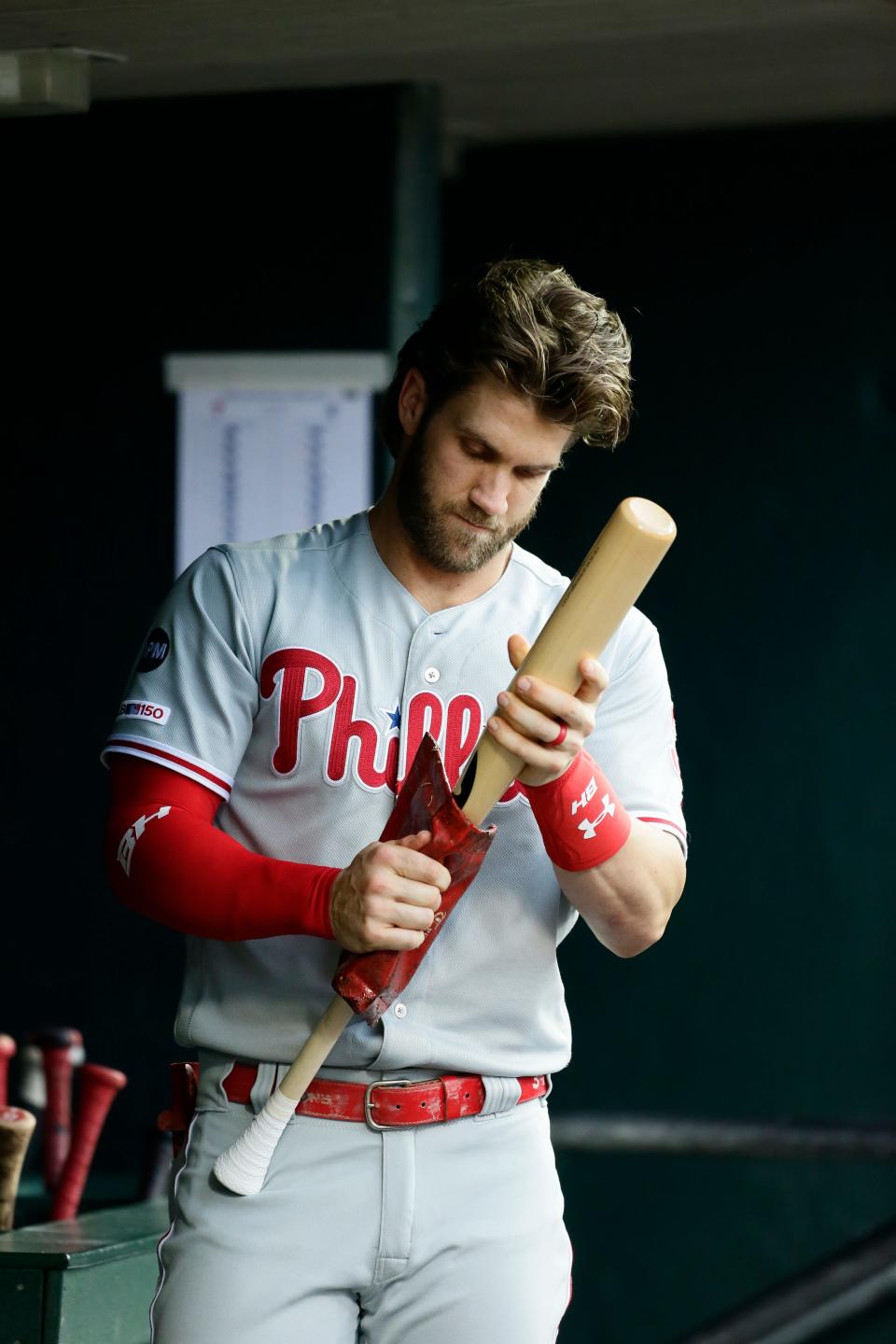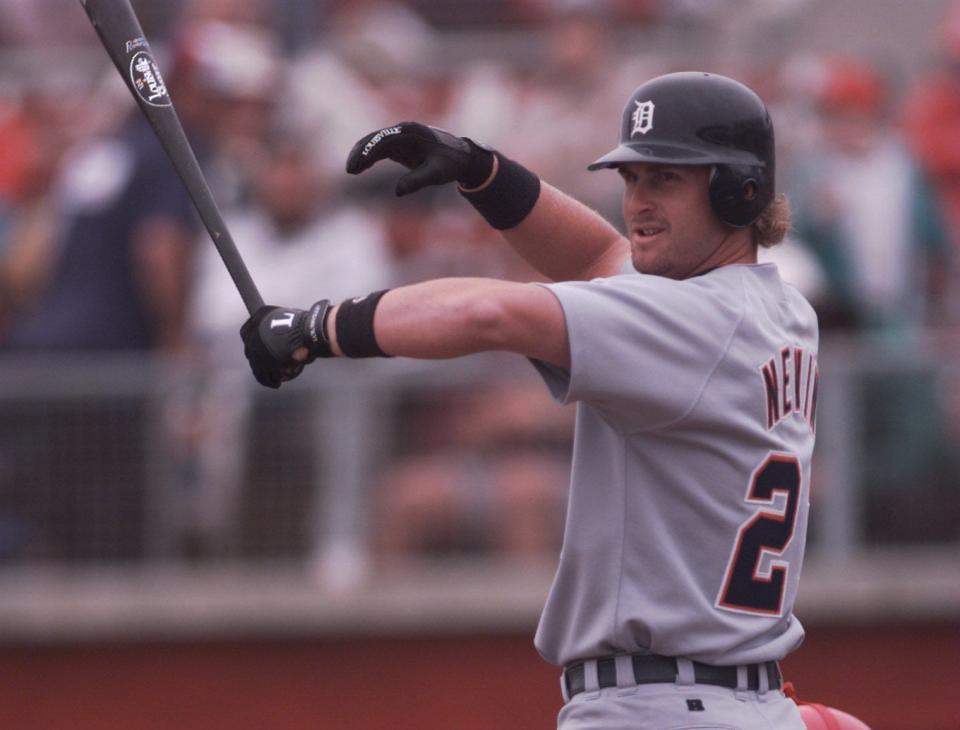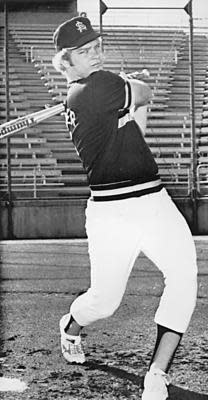Why we might expect a hit from Spencer Torkelson in his Detroit Tigers debut Friday
- Oops!Something went wrong.Please try again later.
- Oops!Something went wrong.Please try again later.
When first baseman Spencer Torkelson takes the field on Friday against the Chicago White Sox, 667 days will have passed since the Detroit Tigers made him the No. 1 selection in the 2020 MLB draft.
It’s a meteoric rise considering Torkelson had yet to take a professional at-bat (outside of spring training) at the same time last year. But then, the former Arizona State star was already part of a select club known for making rapid ascents from the draft to the majors. Torkelson was just the 14th college position player selected No. 1 overall in 56 iterations of the draft, dating back to 1965. (Though MLB teams have gone that route for three straight drafts now, with the Baltimore Orioles taking catcher Adley Rutschman No. 1 in 2019 and the Pittsburgh Pirates going with catcher Henry Davis last July.)

TORK'S BIG DAY: A life-changing day with Tigers: 'All three of us were crying'
JEFF SEIDEL: Tigers were right to push Torkelson to the majors. They should do it more
With Rutschman’s promotion delayed by a triceps strain this spring (as well as the slow page of the Orioles’ rebuild), Torkelson will be the 13th college position player to go from No. 1 to the majors. He won’t be the fastest — that would be 1972’s top pick, at one day — but he also won’t be the slowest — that would be 1992’s pick, a future Tiger who needed more than three years to make it to the majors.
So what can we expect from his debut, as well as his debut season? Perhaps a hit, at least: Eight of his 12 predecessors recorded at least one hit in their debut games. Here’s a look back at the 12 and how they fared in their MLB careers:
2015: SS Dansby Swanson, Diamondbacks
Debut: Aug. 17, 2016.
Days between draft and debut: 437.
The buzz: Swanson was traded to the Atlanta Braves just over six months after his draft, and eight months after that, the former Vanderbilt star was in the majors as a 22-year-old. His first game, against the Minnesota Twins, showed his talent, as he singled twice in four at-bats. He finished the season with a .302/.361/.442 slash line, high-water marks for him until 2020, when he finished 18th in NL MVP voting. He enters 2022 with a career .249/.319/.409 slash line — and a World Series ring from last year.
SHAWN WINDSOR: Tarik Skubal's shutdowns of Bryce Harper show why Tigers' potential is high
2010: OF Bryce Harper, Nationals
Debut: April 28, 2012.
Days between draft and debut: 692.

The buzz: Harper was already on an accelerated path — he got his GED after his sophomore year of high school and spent a season as a 17-year-old at the College of Southern Nevada (with 31 homers in 66 games) before the draft. He was still 19 when he debuted against the Los Angeles Dodgers, going 1-for-3 with a double in his third plate appearance and an RBI sac fly in his fourth. It was the start of a Rookie of the Year campaign in which he hit .270 with 22 homers and 26 doubles in 139 games. He has since won two NL MVP awards (including last year’s) with a career .279/.392/.524 slash line.
1998: 3B Pat Burrell, Phillies
Debut: May 24, 2000.
Days between draft and debut: 723.
The buzz: Burrell was far from a guaranteed star entering the 2000 season, despite his Golden Spikes Award (as the best college baseball player in the U.S.) in 1998; he’d hit just .152 in 10 Triple-A games at the end of 1999. But a 40-game Triple-A stint in 2000 (with a .294 average and 20 extra-base hits) settled the Phillies’ nerves, as did Burrell’s debut, a 2-for-5 performance with a triple and two RBIs against the Houston Astros. The big righty slashed .260/.359/.463 in an offensively charged era to finish fourth in NL ROY voting; he finished his career with an .834 OPS that included 292 homers over 12 seasons.
1995: OF Darin Erstad, Angels
Debut: June 14, 1996.
Days between draft and debut: 379.
The buzz: A multisport star — we’ll give him the benefit of the doubt for being the starting punter for the Nebraska squad that won the 1994 national title — Erstad went right from High-A in 1995 to Triple-A in 1996 while hitting at least .305 the whole time. He was blanked in four at-bats in his debut against the Toronto Blue Jays, but picked it up quickly, hitting .284 with 10 extra-base hits in 57 games to finish sixth in AL ROY voting. He’d go on to make two All-Star games as an Angel — including a top-eight finish in AL MVP voting in 2000 — with a career .282/.336/.407 slash line over 1,654 games.
1992: 3B Phil Nevin, Astros
Debut: June 11, 1995.
Days between draft and debut: 1,105.

The buzz: Famed Tiger Hal Newhouser, an Astros scout, wanted Houston to take Kalamazoo prep star (and Michigan commit) Derek Jeter. Instead, the ’Stros went the cheap route and drafted Nevin, a Golden Spikes runner-up (and All-American kicker for Cal State Fullerton’s football team). Nevin singled in his first career plate appearance then managed just six more hits in his next 68 appearances. When the Astros tried to send him back down, he blasted management with a tirade; so they dealt him to Detroit in mid-August. Nevin finished his rookie year with the Tigers hitting.219 over 29 games. It would be four more seasons — and two more franchises — before he developed into a starter; he made the NL All-Star squad in 2001 with the San Diego Padres.
1986: SS Jeff King, Pirates
Debut: June 2, 1989.
Days between draft and debut: 1,096.
The buzz: Called up to fill in at first base due to an injury to first baseman Sid Bream, the Arkansas product doubled in his first time at the plate, a pinch-hit appearance in the 11th inning against the New York Mets. He struggled to make contact the rest of the season, batting just .195 over 75 games while bouncing around the infield defensively. He eventually settled in at third base the next season with 14 homers in 127 games, and his power stroke developed once he hit his 30s with the Pirates and Kansas City Royals.
1985: SS B.J. Surhoff, Brewers
Debut: April 8, 1987.
Days between draft and debut: 674.
The buzz: Surhoff, a two-time All-American and U.S. Olympian while at North Carolina, is the only player on this list to make his team’s Opening Day roster, though he had to wait until Milwaukee’s second game to debut. He singled in his first plate appearance, too, launching a rookie campaign in which he hit .299 with seven homers and 11 steals while playing catcher, first base and third base over 115 games. He maintained that defensive versatility with 904 games in left field, 704 at catcher, 316 at third and 158 at first (and one game at shortstop, his drafted position) while posting a .282/.332/.413 slash line.
1978: 3B Bob Horner, Braves
Debut: June 16, 1978.
Days between draft and debut: 10.

The buzz: Horner starred at Arizona State, where he set an NCAA record for career homers (58) and was named MVP of the 1977 College World Series. Once they had him under contract, the Braves skipped the minors altogether and started him against the Pirates and future Hall of Famer Bert Blyleven; Horner homered in his third plate appearance. He kept homering, too, for a rookie total of 23 (to go with 17 doubles) in 89 games to win the NL Rookie of the Year Award. Horner’s career was cut short by injuries, but he still hit 218 homers in 1,020 games spread across 10 MLB seasons.
1975: C Danny Goodwin, Angels
Debut: Sept. 3, 1975.
Days between draft and debut: 91.
The buzz: Goodwin was drafted No. 1 twice — the White Sox selected him out of high school in Peoria, Illinois, in 1971, but he opted to attend Southern University instead. After just 163 plate appearances in the minors — with a .275 average and .369 on-base percentage — the Halos decided he was ready for a September test. Goodwin struck out in his first plate appearance (as a DH) against the Rangers, then was replaced by future manager Bobby Valentine. Two days later, he played the whole game, as a DH again, and singled in his first at-bat before striking out three more times. He finished that first season with one hit in 10 plate appearances over four games, with five strikeouts. He never did find his swing in the majors, with a .674 OPS in 252 games. (In Triple-A, however, he mashed, with a .308/.400/.518 slash line in 612 games.)
1974: SS Bill Almon, Padres
Debut: Sept. 2, 1974.
Days between draft and debut: 89.
The buzz: After a 25-game stint in Double-A, in which he hit .186, and a 14-game stint in Triple-A, in which he hit .222, the Pads gave the Brown University product a September tryout in the bigs. He, of course, went 0-for-4 in his debut against the Braves, then picked up 12 hits in his final 34 at-bats of the season to finish with a .316 average. He didn’t return to the majors full time until 1977, then spent a decade as a serviceable, if well-traveled, utility infielder, in stints with the Padres, Expos, Mets (twice), White Sox, A’s, Pirates and Phillies. In 1,236 games, he hit just 36 homers to go with 44 sac bunts and 29 sac flies.
1972: 3B Dave Roberts, Padres
Debut: June 7, 1972.
Days between draft and debut: 1.
The buzz: Roberts, who played shortstop at Oregon and is not the current manager of the LA Dodgers, hit. 410 as a junior and led the nation in home runs (12) en route to Pac-8 and national player of the year honors. And no, that’s not a typo: Drafted on June 6, he signed on June 7 and made his debut at third base that night — in the top of the 12th inning — and went 0-for-3 in an 18-inning 1-0 loss. Roberts appeared in 100 games that season, posting a .244/.275/.321 slash line. He played parts of 10 seasons but never found his niche and finished with a .644 OPS over 709 games.
1965: OF Rick Monday, Athletics
Debut: Sept. 3, 1966.
Days between draft and debut: 452.
The buzz: The very first No. 1 overall pick spent essentially two seasons in the minors before getting a September callup in his second pro season. It did not go smoothly for the former ASU star; he went 0-for-3 in his debut against the Red Sox, 0-for-4 in a doubleheader the next day and then 0-for-7 over seven more games (with some defense-only appearances mixed in). Finally, in the 11th game of his career, he picked up his first hit, a double off future Hall of Famer Jim Palmer and Baltimore. He finished the season hitting .098, but came back with a .740 OPS the next year and an All-Star nod in his third year, part of a 19-season career.
Contact Ryan Ford at rford@freepress.com. Follow him on Twitter @theford. Read more on the Detroit Tigers and sign up for our Tigers newsletter.
This article originally appeared on Detroit Free Press: Expect a hit from Spencer Torkelson in his Detroit Tigers debut

